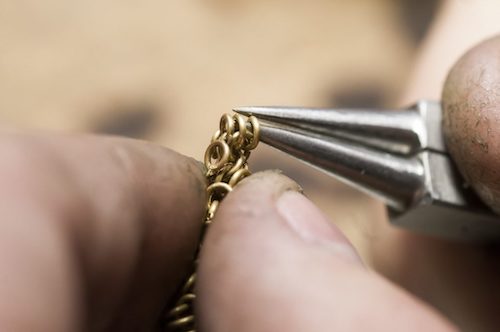1. Chain Repair:
Chain repair involves fixing a damaged or broken chain, whether it’s a necklace, bracelet, or any other jewelry item with a chain link structure. Common issues that require chain repair include broken links, worn-out links, or a completely snapped chain.
What happens during chain repair:
Link replacement: If a link has broken or is damaged, the jeweler will replace or solder the broken link. They may also repair it by rejoining the ends of the chain and securing them with a special technique.
Chain re-soldering: If the chain has become detached at a certain point, such as where a link has snapped or come undone, the jeweler will carefully re-solder the metal ends back together.
Strengthening weak points: In some cases, the jeweler may reinforce areas where the chain is prone to breaking in the future.
Types of chains repaired:
Cable chain (the most common type)
Figaro chain
Rope chain
Snake chain
Box chain
Any other type of link chain can also be repaired as needed.
Why it's necessary: Chain repairs are important for maintaining the integrity of the piece and preventing the chain from completely breaking, which could result in the loss of the jewelry or gemstones.
2. Clasp Repair:
Clasp repair involves fixing or replacing the clasp of a necklace, bracelet, or other jewelry piece. The clasp is crucial to ensuring that the piece stays securely closed, and over time, clasps can wear out or break due to repeated use.
What happens during clasp repair:
Spring ring clasp repair: If the spring ring clasp has lost its tension or the spring has broken, the jeweler will repair or replace the internal spring mechanism.
Lobster clasp repair: The jeweler can repair any issues with the locking mechanism or replace the clasp entirely if it’s not working properly.
Box clasp repair: If the box clasp is misaligned or broken, the jeweler may realign it or replace the clasp mechanism to ensure it locks securely.
Magnetic clasp repair: If a magnetic clasp is no longer attracting properly or the magnets are damaged, the jeweler may replace the magnets or fix the clasp structure.
Why it's necessary: A faulty or broken clasp can cause the jewelry to come undone, leading to potential loss or damage. A working clasp ensures that the jewelry stays securely in place.
Common Types of Clasps:
Lobster Clasp: A popular clasp type that is spring-loaded and secure.
Spring Ring Clasp: A small, circular clasp that opens when a spring is compressed.
Box Clasp: A clasp with a box and tongue mechanism, often used in more formal pieces.
Toggle Clasp: A clasp that uses a bar and loop mechanism, often seen in more casual or chunky designs.
Magnetic Clasp: Uses magnets to secure the jewelry, offering convenience but may not be as secure as other clasp types.
S-Hook Clasp: A simple clasp in the shape of an "S" that hooks into a loop to secure the jewelry.
Why You Might Need Chain or Clasp Repair:
Chain: Over time, chains can get caught on things, causing them to stretch, break, or become weakened. Regular wear and tear, such as tugging or pulling on the chain, can also cause links to break.
Clasp: Clasps wear out or break due to repeated opening and closing or because of metal fatigue. If the clasp is no longer working properly, your jewelry could fall off and be lost.
How Repair Works:
Inspection: A jeweler will carefully inspect the chain or clasp to determine the issue and decide whether a repair is needed or if a replacement part is required.
Repair/Replacement: The jeweler will either repair the clasp or chain, or they may replace damaged components with new parts.
Polishing and Finishing: After the repair, the piece is usually cleaned, polished, and inspected to ensure it’s functioning properly and looks as good as new.
Is Your Chain or Clasp in Need of Repair?
If your chain has broken or your clasp isn't closing properly, it’s definitely worth getting it looked at by a professional. A jeweler can restore your jewelry to its original condition and ensure that it stays secure. Do you have a specific chain or clasp issue you’re dealing with?


